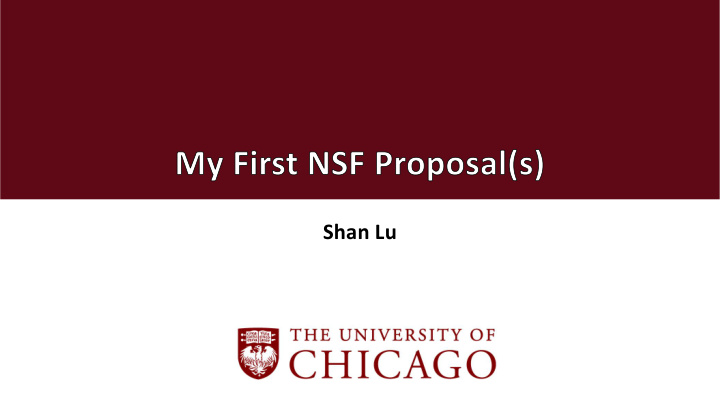



Shan Lu
1 ❑ Dec. 2008 , thesis defense @ Univ. of Illinois ▪ “Understanding, Detecting, and Exposing Concurrency Bugs ” ❑ Jan. 2009 , starts @ Univ. of Wisconsin ❑ Jul. 2009 , should I write a proposal or paper or both? ❑ Nov. 2009 , paper accepted by ASPLOS ▪ “ ConMem: Detecting Severe Concurrency Bugs through an Effect-Oriented Approach ” ❑ Dec. 2009 , submit my first NSF proposal (small, single PI) ▪ “Fighting Concurrency Bugs through Effect-Oriented Approaches ” ❑ July 2010 , submit my CAREER proposal ▪ “CAREER: Combating Performance Bugs in Software Systems”
2 ❑ Understanding, Detecting, and Exposing Concurrency Bugs
3 ❑ Understanding, Detecting, and Exposing Concurrency Bugs ▪ What are concurrency bugs? data races , atomicity violations, … ▪ Which code regions need to be atomic?
4 ❑ “I should do something different from what I did as a student” ❑ “should I?”
5
6
7
8 So what?
9 ❑ It starts from my ASPLOS work
10 ❑ It is much broader than my ASPLOS work
11 ❑ A combination of ”it definitely will work” + “it might work”
12
13 ❑ Leverage past strength ❑ Different from Ph.D. work ❑ It is a 5 -year project
14
15
16
17
18 ❑ My concurrency bug proposal ▪ ASPLOS’11, PLDI’11, OSDI’12, ASPLOS’13, ASPLOS’14, FSE’14 ❑ My CAREER ▪ PLDI’12, ICSE’13, CAV’13, OOPSLA’14, ICSE’15, ICSE’17, ASPLOS’18 ❑ Span out to more projects funded by NSF CNS & CCF
19 ❑ Do good research → Write good proposal ❑ Have good graphs ❑ Have a mix of thrusts in the proposal ❑ Get advice from other people ❑ Don’t be scared
Recommend
More recommend